A Fifteen Year Report on Vireya Rhododendrons in Southern California
A Comprehensive Study of their Cultural Requirements
Carl A. Deul, Northridge, CA
Nature is full of wonders and the plant kingdom is no exception to this. Often intriguing surprises turn up when new plant material is introduced into cultivation and attempts are made to grow the newcomers in various climate and garden situations. Some plants show a great deal of promise as being very adaptable because of their harsh nature habitat but have turned out to be somewhat fussy in cultivation; whereas, others have turned out to be the complete reverse of this situation.
Unfortunately as mortals, we all suffer from the same problem; in that, we are limited in our resources of time and the necessary tools to perform the necessary controlled experiments and tests under varying climatic conditions to fully evaluate a new plant introduction. At best, we can observe the plant's behavior in our own microcosm, and if fortunate to travel to other areas where the same plant is being grown in a completely different situation, we can draw comparisons. If we advise others based on our own speculations, we sometimes find ourselves with the proverbial "egg on our face". The situation is much like trying to look for canals on Mars from a telescope located on earth. An example of this is in a recent publication by a noted rhododendron authority and author in which he states that Hymenanthes are not really successful in southern California". Similar lines of thought prevailed in the San Francisco Bay area prior to early 1970 in regard to how well and which vireya rhododendrons might have the best chance of doing well in southern California. The belief was that only the more "heat tolerant" species or hybrids would be the best for our area.
Interestingly, the Southern California Chapter membership has found that, when properly cared for, there are very few vireya rhododendrons that can't grow and bloom well in southern California. The primary limiting factor seems to be the water quality (level of dissolved minerals) where they are being grown.
I suspect that much of the misunderstanding by outsiders as to what will or will not grow well for us stems from the wide publicity of high temperatures of the southern California desert areas; namely, Palm Springs and Death Valley. In reality, the climatic
conditions experienced within 20 miles of the southern California coast are comparable to those of Long Island, New York, during the periods from June through September. Interestingly, the average daily temperatures of Tokyo, Japan, which is further north, are as much as 10° F higher than Los Angeles, California, during the period from July to late August. The reason for this is the moderating west to east air movement from the cool Pacific Ocean to the California inland area. This air movement occurs on all but a few days out of the year which lowers our evening temperatures as much as 20° F. This is an important factor in our climate and may explain why we can grow and bloom a greater assortment of varieties in our area than can be grown in southern Florida.
As a point of reference, I should give a brief history of the vireya rhododendrons in southern California.
The first known introduction of vireya rhododendrons on a test basis was around the year of 1965 when Nuccio's Nursery of Altadena, California, obtained plants of 'Princess Alexandra', Pink Delight and 'Taylori' from Domoto Nurseries in Hayward, California. The reaction of the Nuccios was one of pleasant surprise when the plants began to bloom on-and- off sporadically throughout the year. However, the Nuccios did not take a serious interest in the plants until after the mid-1970's.
During the period from 1968-1971, Huntington Arboretum acquired about thirty varieties from Longwood Gardens and Strybing Arboretum. Unfortunately, these were planted out in the garden directly into the heavy soil. Most of the collection was lost through the years.
In 1971 William "Bill" Moynier contacted Roy Hudson at Strybing Arboretum in regard to the vireya rhododendrons and subsequently was introduced to Pete Sullivan at Strybing. Bill had a long time interest in rhododendrons and had already been successful in growing a number of broadleaf (or Hymenanthes) hybrids in his yard. During this time period, Bill had begun to hybridize the common rhododendrons to produce varieties better suited for our climatic conditions.
Pete Sullivan provided Bill with a number of his scions, seedlings and small vireya rhododendron plants to test in his area. Fortunately, Bill had had enough experience with other rhododendrons and azaleas to know that they grew and performed much better when planted in peat moss/Perlite mixes as opposed to planting them in our heavy southern California soils. Within a few years, his vireyas began to bloom and he started a program of hybridizing this group.
Early in 1973 this author became intensely interested in azaleas and rhododendrons. By constant badgering of the local nurseries, I was finally directed to Ted Van Veen in Portland who sold me some of my first rhododendrons. I had heard about the vireya rhododendrons and was referred to Pete Sullivan at Strybing and Bill Moynier in West Los Angeles by Ted Van Veen. During my first conversations with Pete, he also recommended that I contact Bill and benefit from his experience with the vireyas in southern California.
During the fall of 1975 with the assistance of Bill Moynier, Hadley Osborn and Ted Van Veen, the Southern California Chapter was formed. Additional mention should be given to my wife, Marie, who handled all the Chapter correspondence and to Bea Jones Wyse, our very capable newsletter author, until her death in 1977. The vireya rhododendrons were an instant success with the new membership. During the time period from 1975 to the present, many small plants and seedlings have been distributed to many plantsmen in southern California.
Since the start of our intense interest in the vireyas, we have spent a great deaf of time comparing experiences with hobbyists in different parts of the world who have been growing these plants and noting the growth responses in several micro-climates in the southern California area. Although this author feels that we are just at the threshold of the beginning of understanding what controls the vireyas, there are patterns that are beginning to develop. Some information needs to be disseminated and cultural recommendations published to help others to enjoy these most fascinating plants. With this in mind, we arrive at the prime reason for this article.
In the following discussion of observations that have been made concerning the vireya rhododendrons, I have tried to be as objective as possible in each case.
EPIPHYTIC TENDENCIES
- Although they do grow on the ground in their native habitat whenever they have sufficient light to do so, in cultivation they respond best if their epiphytic tendencies are kept in mind when formulating their growing medium.
In our discussions with Pete Sullivan, he has often alluded to his experiences with certain species and hybrids that tended to be very epiphytic. He elaborated on his statement by describing the tendency of these varieties to send their roots along the surface and to be reluctant to penetrate their roots down into the soil medium. Interestingly, we have not observed this problem in our area with the same varieties. I should qualify this statement in that some varieties do prefer more aeration in their soil medium than others; these particular fussy varieties experience a higher mortality rate if they are not repotted every two years or so. We can offer no explanation for this difference but surmise that there are some environmental factors entering into the picture.
BUDDING AND BLOOMING
- There have been different reports on varying degrees of success with hobbyists getting their plants to bloom. From our observation deck, we can see several possible causes for the lack of reliable flower bud production. Assuming the plants are being properly fertilized, we will ignore this subject for the moment. One reason could be too frequent pruning, a second could be lack of sufficient seasonal temperature variation.
The vireyas are quite different from any other rhododendrons and one big difference is that the chemical changes that occur in any one branch on a plant, which cause it to bloom, are set into motion as much as a year in advance of the appearance of the flower buds. This is demonstrated in the appearance of flowers on one year old rooted cuttings. These rooted cuttings do not show flowers again until the plants are 3-4 years old.
Although the vireyas come from areas that are classified as having tropical climates, there is some very strong evidence that their growth is tied to the gradual average temperature variations that occur from one season to the next.' We have been conducting a controlled experiment for four years in which at least one variety has been grown at a constant year around temperature of 70°F. The plants are inconsistent in their growth patterns and have yet to bloom. As a contrast, we have grown plants of the same age and variety outside and in a cool greenhouse where they have been exposed to these temperature variations; all of these plants have grown reliably and have bloomed for two consecutive years. There are differences from hybrid (or species) to the next and some require much less temperature variation than others.
Some previous articles on this subject have suggested withholding water during the summer months to stress the plants inducing them to bud. Our experiments with this practice have been inclusive and need to be tried under various other climatic conditions before this can be proven one way or the other.
SALT TOLERANCE, FERTILIZATION AND CHLOROSIS
- During the California drought, which reached its peak during the summer of 1977, most of the metropolitan Los Angeles area was receiving water from the Colorado River. This water, in addition to being alkaline, is very high in mineral salts (775 parts per million) which had a detrimental effect on many types of plants being grown here. During the bad water period, we had an opportunity to see how many types of rhododendrons would survive under these adverse conditions. The vireya rhododendrons compared quite well with the evergreen azaleas which are very salt tolerant; only a few plants gave out under the stress. The most visible signs of the effects of the bad water were defoliation of many of the leaves of the plants just below the terminal rosette and slight discoloration of the leaves between veins near the leaf margins. All in all, we were favorably impressed with the unplanned test.
There is one statement that I have heard mentioned by more than one experienced plantsman growing the vireya rhododendrons; that is that they resent being fertilized often. I would have to disagree with this stand. I use a fertilizer injection on my watering system and the plants receive a constant low level supply of nutrients every time I water. There has been no observable detrimental effects over the past four years from this practice, in fact, the reverse seems to be true. We have had a number of very favorable comments from other experienced vireya growers on the foliage quality, lush growth and vigorous root systems of our plants. Perhaps from the results of these experiments, the statement should be amended to, "vireyas enjoy a low level supply of nutrients (nitrogen less than 80 ppm) but may resent large doses of fertilizer, particularly the types which supply only one or two of all the required nutrients". In regard to which nutrients are necessary for the vireyas, they are not that much different from the more common broadleaf types. As reported earlier by Bob Ticknor and J. L. Long
2
, the calcium to magnesium ratio seems to be very important in the broadleaf rhododendrons. Our experience with the vireyas indicates that this is true with this group also. With a ratio of 1:1, there was considerable leaf stunting and chlorosis. When we increased the ratio to 4:1, there was a dramatic change in the new growth with an increase in leaf size and lush green coloration. Chlorosis in vireyas, as in other plants, is caused by either a nutrient deficiency or unbalance. Pete Sullivan remarked to me that he had seen cases of chlorosis in vireyas that had been induced by excessive amounts of fertilizer. We have seen similar examples with plants grown by a few of our local chapter members. In most cases, the problem is cleared up by application of small amounts of chelated micronutrients. Iron deficiency is not always the problem so it is preferable to use a chelated micronutrient mix with iron, manganese, zinc and copper.
Our Chapter has been conducting some studies on nutrient levels through leaf analysis but, at this time, we are not ready to publish any results. In passing, I should mention that fertilizers and their formulation are not as critical outside the areas that have water problems similar to southern California's. There are a number of individuals (Tom Tatum and Frank Mossman to name two) in northern California and the Pacific Northwest who have successfully grown the vireyas with very little fertilizer being used. There is a need, however, to formulate a good slow release fertilizer for these plants which will enable even the most inexperienced plantsmen to grow the healthiest possible plants.
DROUGHT TOLERANCE, WATER REQUIREMENT AND ROOT DISEASES
- Although the vireya rhododendrons come from a tropical region of the world they have a tremendous ability to withstand drought which far exceeds that of all other types of rhododendrons. For some reason unknown to us, they are also extremely tolerant to dry air.
This drought tolerance can work to the advantage of the person living in a hot climate as the root system can be allowed to become very dry between watering and help to resist root rot problems.
In southern California we have had very few problems with losing plants from root rot when they have been grown in the light airy mix that our Chapter recommends.
This covers many of the important observations that have been made and conclusions drawn from studies made on the vireya rhododendrons in southern California and other areas as well. From this information we would like to offer the following cultural recommendations:
GROWING MEDIUM
- All of the experienced plantsmen that I have talked with who are growing the vireyas successfully are using mixes based on the widely publicized Cornell Mix. Our Chapter uses the same mix that Strybing Arboretum recommends which is equal parts of these three ingredients: coarse peat moss, orchid bark (¼"-⅝"diameter fir bark) chips, and coarse Perlite. John Swisher, our associate member in Florida, uses equal amounts of coarse peat moss and Turface (a product of W.R. Grace Co.).
If you are a beginner, I would suggest that you start with these two formulations. Other materials can and have been used; however, one should keep in mind that some organic materials decompose much more rapidly than others and not all components serve the same purpose. Peat moss, pine needles and Vermiculite are basically water holding materials, whereas bark chips, Perlite, Turface, pumice, and lava stone are aerating materials. Any mix for vireyas should contain at least 50% aerating material.
RAISED BEDS AND CONTAINER GROWING
- Our Chapter does not recommend growing vireyas (or other rhododendrons) "in-the-ground" in southern California, because of the heavy soils which cause water accumulation and eventual root rot problems. The acceptable method is to grow vireyas "on-the-ground" in raised beds of red brick or railroad ties to overcome the problem of water accumulation. A second preferred method is the use of red clay pots or redwood tubs which should also be a popular method of culture in areas where the winter temperatures drop below freezing.
GROWING VIREYA RHODODENDRONS AS HOUSE PLANTS OR IN COOL GREENHOUSES
- Those individuals who have been successful in blooming vireya rhododendrons as houseplants have grown them out of doors during the late spring through early fall when there is no danger of freeze. During the late fall, winter and early spring, the plants are brought indoors and kept in a well lighted and cool (40°-55°F) room. This practice will help to provide the greatest possible seasonable temperature fluctuation. I should also mention that I have never noticed any adverse effects from moving plants in bloom from our humid greenhouse to our residence with low humidity level.
For a cool greenhouse the recommendations by Frank Doleshy
3
provide a good guide for construction of this type of greenhouse. A few points could be added to this discussion. First, it may be necessary in order to bloom some species and varieties in cool summer climatic areas such as Seattle and Vancouver, to use supplemental daytime heating from July through August to bring the daytime temperatures up to 70°-80°F. In milder climatic areas, it may be necessary to use daytime cooling at times during the period from late October through late April in order to keep the daytime temperatures below 70°F.
WATERING PRACTICES
- In southern California we have had the best results by watering well, when we do, and then allowing the growing medium to become dry before re-watering. In most cases, large plants (2 years old and older) will require only weekly watering. The important point here is to avoid perpetually soggy conditions.
PINCHING AND PRUNING
- If you don't care if your plants do not bloom until they are 4-5 years old from cuttings, a great deal of pinching and pruning can be performed during the first three years. A compromise which should enable most varieties to bloom in 3-4 years from a cutting is to pinch as the new growth flushes appear and prune back about ⅓ of the larger stems to the lower rosettes of leaves each year. As a point of interest, the more leggy upright growing plants tend to be more difficult to get to produce multiple breaks through pinching. Usually these types are best controlled through pruning.
FERTILIZER AND FERTILIZER APPLICATION
- The best time to fertilize vireyas is when they are in active growth or in the process of flower bud formation. Monthly application of a good rhododendron fertilizer at a rate ¼ the rate recommended for other types of rhododendrons during the active growing season should provide satisfactory results. Some individuals recommend dilute fish emulsion and speak highly of it. This author does not use it as it is usually high in sea salt.
Bill Moynier recommends a mix of equal amounts of cotton seed meal and an organic camellia mix. He applies it at a rate of 2 lbs./100 square feet of bed area or ¼ tsp/gallon of container volume every three months.
MILDEW CONTROL AND FROST PROTECTION
- In checking with our county agricultural advisers on the subject of mildew, we were told that the conditions most favorable to the growth and spread of this group of fungi are cool damp or moist evenings (causing wet leaves) and hot dry days. The conditions to be avoided is watering late in the afternoon and the misting of leaves. Mildew can build up tolerance to a fungicide so it is best to use more than one kind and to rotate their application. The following have been tested on vireyas and have been found effective and safe to the plants: Benlate (Benomyl), Fungine (Triforine), Karathane and Phaltan. Pipron and Parnon should be effective; however, I have not had any reports on them. The specified application rate is 1 tsp / gallon of spray; spraying plants weekly during the late spring and early fall usually controls the problem.
Another method which is effective is to grow vireyas below a roof overhang or patio roof to prevent dew from falling on the leaves at night. They should, however, receive direct morning sun up to about noon for best flower bud protection. This location for growing of these plants helps in protection against frost.
Although most of the vireyas have not been rated as to hardiness, most will tolerate temperatures down to 27°F for short periods during the night under an open sky. With overhead protection they seem to be able to tolerate down to 25°F (or possibly even lower).
INSECT AND PEST CONTROL
- In southern California we have had a few pest problems. Out of doors common garden pests are aphids, thrips and katydids which can be controlled with Malathion or Orthene. Spider mites can be controlled with Vendex and Kelthane. Cygon 2E should not be used as it causes defoliation on some varieties.
Indoors and inside the greenhouse, aphids, mealy bugs (controlled with Malathion and Orthene) and spider mites are the most common pests.
The cultural practices outlined should be of assistance to anyone who has contemplated trying to grow the vireya rhododendrons but has not already done so. In the following list of varieties, we have listed a few of the many vireya rhododendrons we have bloomed in southern California. The list is confined to plants that have bloomed for at least three consecutive years and have performed at more than one location.
R. brookeanum
v.
gracile
(U.S.D. P.I.N. 257475)
R. christianae
x
R. macgregoriae
R. christianae
x
R. laetum
'Calivar' (
R. konori
x
R. zoelleri
)
'Kurt Herbert Adler' (
R. lochiae
x
R. phaeopeplum
)
R. laetum
(Strybing form)
R. laetum
x
R. zoelleri
(one form named 'George Budgen' has not been the best form for our area)
R. lochiae
(several forms)
R. lochiae
x
R. gracilentum
(Pink and Red forms)
R. lochiae
x
R. javanicum
R. lochiae
x 'Island Sunset'
'Narnia' (
R. aurigeranum
x
R. zoelleri
)
'Ne Plus Ultra'
'Pink Delight'
'Pink Delight' x
R. jasminiflorum
'Red Prince'
'Princess Alexandra'
'Shasta' [
R. konori
x ('Pink Delight' x
R. jasminiflorum
)]
'Sybil'
'Taylori'
R. zoelleri
x
R. konori
(Bill Moynier's #205 & 206)
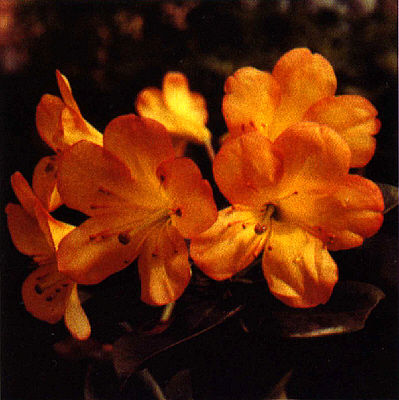
|
|
R. 'Souvenir of J. H. Manglis' x
R. laetum
|
|
|
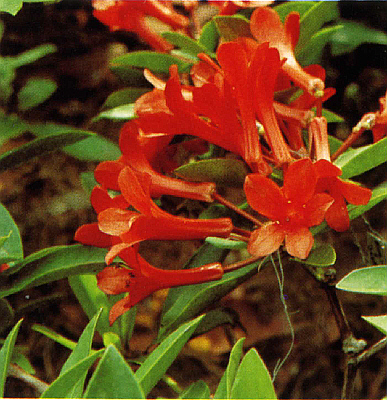
|
|
R. 'Ne Plus Ultra'
|
|
|
All Photos by Carl Duel
|
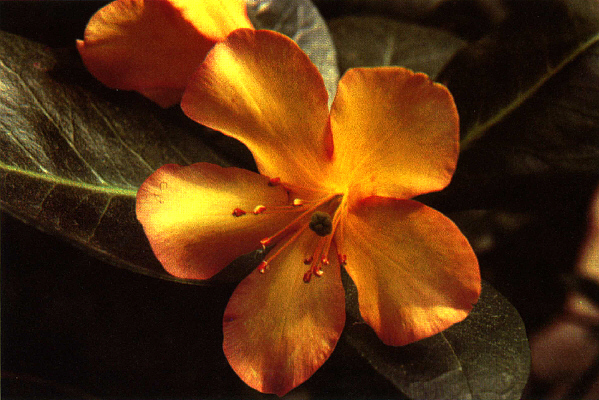
|
|
R. laetum
x
R. leucogigas
|
|
|
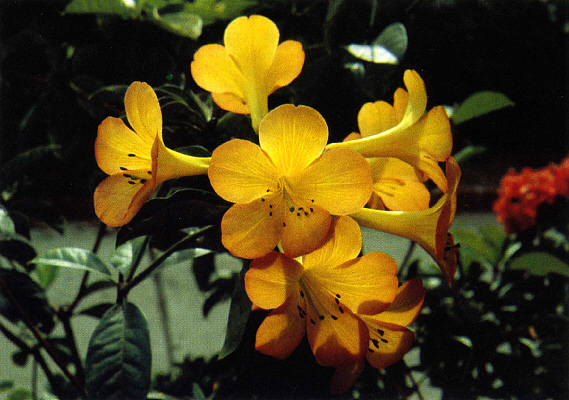
|
|
R. 'Narnia'
|
|
|
All Photos by Carl Duel
|
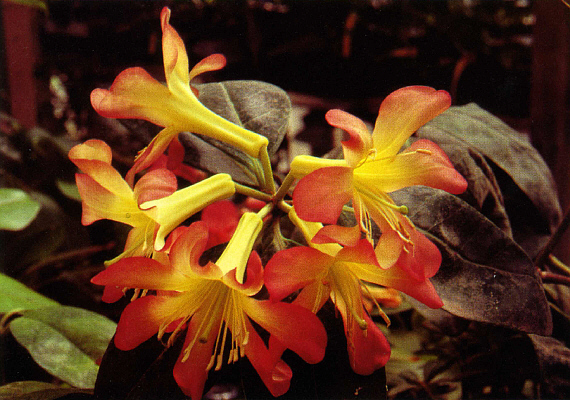
|
|
R. zoelleri
x
R. konori
|
|
|
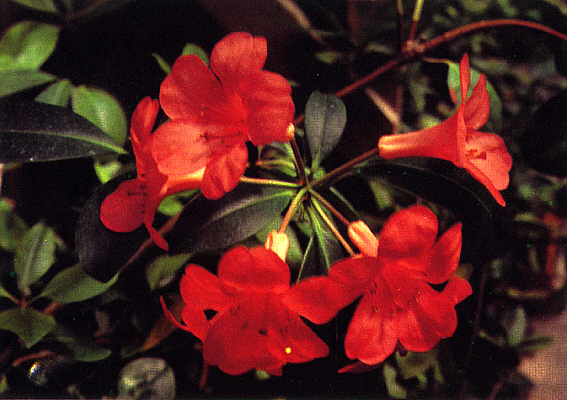
|
|
R. lochiae
x 'Island Sunset'
|
|
The vireya rhododendrons have a bright future in the horticultural community. As new and better hybrids are developed which will be easier to bloom and care for, they should receive acceptance by the general public as house plants. As for southern California, it remains to be seen if these will gain general public acceptance because of the lack of interest by the general public and retail nurseries in plants that require any extraordinary care. Unless there is a shift in the general public's attitude these will remain plants for the more avid gardener.
BIBLIOGRAPHY
1. A New Greenhouse, Cool but Comfortable by Frank Doleshy, ARS Quarterly, Vol. 33, No. 2, pp. 97.
2. Mineral Content of Rhododendron Foliage by R. L. Ticknor and J. L. Long, P. 158.
3. A New Greenhouse, Cool but Comfortable by Frank Doleshy, ARS Quarterly, Vol. 33, No. 2 pages 95-99.





